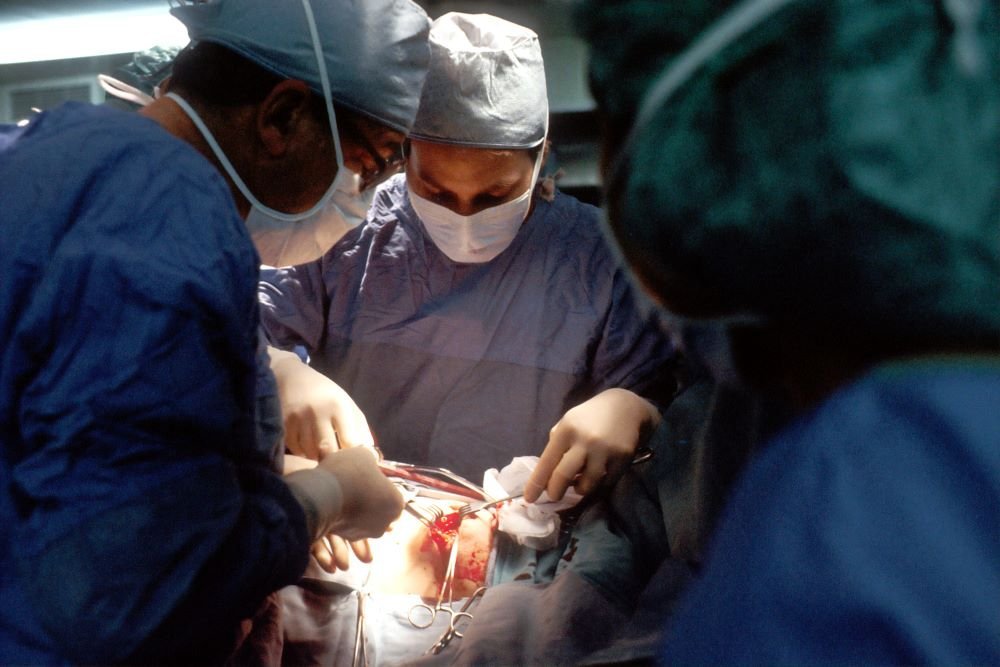What is the main cause of pneumothorax?
Pneumothorax is commonly caused by a puncture or tear in the lung tissue, usually due to chest trauma. Other causes might include medical procedures, such as thoracentesis (removal of excess fluid from the pleural cavity) or mechanical ventilation. Some underlying medical conditions, such as chronic obstructive pulmonary disease (COPD), cystic fibrosis, or lung cancer, may also increase the risk of developing pneumothorax.
Sometimes finding a reason for a pneumothorax is impossible, especially in young, tall and thin patients. In those cases, we call it idiopathic pneumothorax.
What are the three signs and symptoms of a pneumothorax?
1) Sudden and severe chest pain on one side that may worsen with deep breathing or coughing.
2) Shortness of breath may become more severe as the pneumothorax progresses.
3) Rapid heart rate and low blood pressure if the pneumothorax is large enough to compress the heart or major blood vessels.
How serious is a pneumothorax?
A pneumothorax, also known as a collapsed lung, can be a serious condition depending on the severity and underlying cause. It occurs when air leaks into the space between the lung and the chest wall, causing the lung to collapse.
If left untreated or if there is a large pneumothorax, it can lead to significant breathing problems, chest pain, and even death. However, a small pneumothorax may not cause any symptoms and may even resolve on its own.
Treatment options vary depending on the size of the pneumothorax and the underlying cause but can include observation, oxygen therapy, needle aspiration, or chest tube insertion. It’s important to seek medical attention if you suspect a pneumothorax or are experiencing any troubling symptoms.
How do they fix pneumothorax?
Treatment for a pneumothorax depends on its severity and whether it is a primary or secondary pneumothorax.
In a primary pneumothorax (occurring without an underlying lung disease), treatment may include:
– Observation: If the pneumothorax is small and causing no symptoms, the patient may only need to be closely monitored to ensure it does not worsen.
– Oxygen therapy: Giving the patient oxygen can help the lung tissue to reabsorb the trapped air.
– Aspiration: A needle will be inserted through the chest wall to remove the air.
– Chest tube insertion: A flexible tube will be inserted through the chest wall into the pleural space to remove the air and allow the lung to re-expand.
In a secondary pneumothorax (occurring as a result of lung disease), treatment may include:
– Diagnosis and treatment of the underlying condition (e.g. pneumonia, COPD, lung cancer, etc.)
– Oxygen therapy
– Chest tube insertion
– Surgery: A procedure may be necessary to prevent further episodes of pneumothorax.
It’s important to seek medical attention immediately if you suspect you have a pneumothorax, as this condition can be life-threatening if left untreated.
Does pneumothorax happen suddenly?
In many cases, pneumothorax can occur suddenly without any warning signs or symptoms.
Some common symptoms of pneumothorax include sudden chest pain that worsens with breathing or coughing, shortness of breath, rapid heart rate, or a feeling of tightness in the chest. If you suspect you may be experiencing pneumothorax or any other medical emergency, it’s important to seek immediate medical attention.
Should I be worried if I have pneumothorax?
If you suspect you have pneumothorax or have been diagnosed with it, it is important to seek medical attention immediately. Pneumothorax is a medical emergency and can lead to severe respiratory complications if left untreated. Your doctor will determine the appropriate course of treatment, which may include oxygen therapy, chest tube placement, or surgery. Following your doctor’s orders and avoiding vigorous activity and anything else that could worsen your condition is essential. Some patients have no symptoms at all, and the pneumothorax might resolve on its own; in any case, a chest x-ray is strongly advisable.
Can pneumothorax cause sudden death?
A pneumothorax (collapsed lung) can potentially lead to sudden death if it is not promptly diagnosed and treated. This is because lung collapse can pressure the heart and other vital organs, leading to decreased blood flow and oxygen delivery. In severe cases, this can cause cardiac arrest and death. However, with prompt medical intervention, such as a chest tube placement or surgery, most people with pneumothorax can be successfully treated and recover without any long-term complications. If you are experiencing symptoms of pneumothorax, such as chest pain, shortness of breath, or sudden, sharp pain in the chest, you should seek emergency medical care immediately.
Does Covid cause pneumothorax?
Pneumothorax is not a known common symptom or complication of COVID-19. However, COVID-19 can cause pneumonia, which is a condition that can sometimes lead to the development of pneumothorax as a complication. Some patients with covid get intubation in intensive care, which can lead to pneumothorax, which is quite difficult to treat.
How long are you in the hospital for a pneumothorax?
The length of time a person spends in the hospital for pneumothorax can vary depending on the severity of the condition and the type of treatment required. In general, a small pneumothorax may only require a short hospital stay of a few days. In contrast, a larger pneumothorax or one that requires surgery or other interventions may necessitate a longer hospitalisation of a week or more. Ultimately, the length of time a person spends in the hospital for a pneumothorax will depend on the individual circumstances of their case, and their healthcare provider will be able to give them more specific information.
What is the outcome prognosis of pneumothorax?
The prognosis of pneumothorax can vary depending on factors such as the size and cause of the pneumothorax, the individual’s overall health, and whether any complications are present. Generally, small pneumothoraxes without complications can be treated effectively and have a good prognosis. However, larger pneumothoraxes or those accompanied by other medical conditions may be more serious and require more aggressive treatment. Post traumatic pneumothoraxes have an excellent outcome.
It is best to consult a medical professional for an accurate prognosis based on individual circumstances.
What are the two complications of a pneumothorax?
There are several complications associated with a pneumothorax (collapsed lung), but here are two common ones:
1. Tension pneumothorax occurs when the air that leaks into the pleural space (between the lungs and the chest wall) continues accumulating and builds up pressure. This increased pressure pushes the affected lung and other organs towards the opposite side of the chest, causing compression and impaired blood flow in the heart, great vessels, and other organs. Tension pneumothorax is a medical emergency that can lead to cardiovascular collapse, shock, and death if untreated.
2. Recurrence of pneumothorax: Even after successful treatment of pneumothorax, there is a risk of reoccurring, especially in people with underlying lung diseases (such as emphysema) or those who engage in activities that increase their risk of lung injury (such as smoking or scuba diving). Recurrent pneumothorax can cause further lung damage and complications and may require additional treatment, such as surgery.
What is the surgery for pneumothorax?
The most common surgery for pneumothorax is a procedure called a video-assisted thoracoscopic surgery (VATS). During this procedure, the surgeon makes an incision in the chest and inserts a small camera and surgical instruments to remove any air or fluid that has accumulated in the pleural space (the area between the lung and the chest wall). In some cases, the surgeon may also place a chest tube to help drain any remaining air or fluid. The choice of surgery will depend on the severity of the pneumothorax and the preferences and experience of the surgeon. Generally speaking, the surgical procedure aims to resect the weakest area of the lung, which is generally at the top, and also to make the lung get stuck to the chest wall to reduce the risk of recurrence. This can be achieved by either mechanical means (stripping or scraping the lining of the chest wall) or chemical means (such as talcum powder, blood or antibiotics instilled into the chest cavity). Most patients can go home in a day or two and can resume normal activities in a few weeks.
Is pneumothorax associated with endometriosis?
There is no clear association between pneumothorax and endometriosis. On the other hand, endometriosis is a condition in which the tissue that normally lines the uterus grows outside, causing pain and infertility. Sometimes there is an association between the two conditions and the pneumothorax or its symptoms, like sharp pain occurring around the period. This is a condition called catamenial pneumothorax and requires specialist attention from an experienced surgeon as the overall treatment is different from normal pneumothoraxes.
Are there any other rare causes of pneumothorax?
Yes, there are other rare causes of pneumothorax apart from the common causes, such as chest trauma, lung disease, and medical procedures.
Some of the rare causes of pneumothorax are:
1. Spontaneous pneumothorax occurs without any underlying lung disease or injury. It is more common in tall, thin people and smokers.
2. Catamenial pneumothorax: This type of pneumothorax occurs in women during their menstrual cycle due to endometriosis affecting the lung tissue.
3. Langerhans cell histiocytosis: This is a rare disorder where the Langerhans cells in the lung tissues multiply abnormally and cause damage to the lung tissue.
4. Marfan syndrome: This genetic disorder affects the connective tissues in the body and can lead to the development of lung bullae, which can rupture and cause pneumothorax.
5. Birt-Hogg-Dubé syndrome: This is a rare genetic disorder that can lead to the formation of lung cysts that can rupture and cause a pneumothorax.
6. Lymphangioleiomyomatosis (LAM) is a rare and progressive lung disease that primarily affects women of childbearing age. It is characterised by an abnormal growth of smooth muscle cells, which can lead to the formation of cysts in the lungs, lymph nodes, and other organs in the body. LAM can cause various symptoms such as shortness of breath, coughing, chest pain, and fatigue. It is a chronic condition that requires ongoing management and treatment. While there is no cure for LAM, treatments such as medication, oxygen therapy, and lung transplantation can help manage the symptoms and improve quality of life.
It is important to note that these rare causes of pneumothorax are not very common, and your doctor will evaluate your medical history and conduct diagnostic tests to determine the underlying cause of your pneumothorax.






